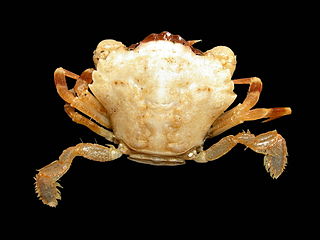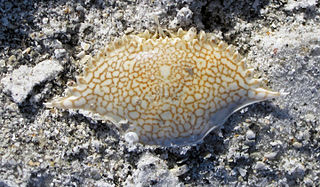
Ovalipes ocellatus, known as the lady crab, is a species of crab from eastern North America. Other names for it include the leopard crab or Atlantic leopard crab due to the leopard-like rosette patterns on its shell, the calico crab, or ocellated crab. It has a shell 3 in (7.6 cm) long and only slightly wider, which is covered in clusters of purple spots. It occurs from Canada to Georgia, and lives mainly on molluscs, such as the Atlantic surf clam.

The velvet crab, also known as the velvet swimming crab, devil crab, fighter crab, or lady crab, is a species of crab from the North-East Atlantic and the Mediterranean. It is the largest of the swimming crab family (Portunidae) found in British coastal waters. It has a carapace width of up to 100 millimetres (3.9 in), and is the only species in the genus Necora. Its body is coated with short hairs, giving the animal a velvety texture, hence the common name. It is one of the major crab species for United Kingdom fisheries, in spite of its relatively small size.

Portunus pelagicus, also known as the blue crab, blue swimmer crab, blue manna crab and flower crab is a species of large crab found in the Indo-Pacific, including off the coasts Indonesia, Malaysia, Cambodia, Thailand, the Philippines, and Vietnam; and in the intertidal estuaries around most of Australia and east to New Caledonia.

Portunidae is a family of crabs which contains the swimming crabs. Its members include many well-known shoreline crabs, such as the blue crab and velvet crab. Two genera in the family are contrastingly named Scylla and Charybdis; the former contains the economically important species black crab and Scylla paramamosain.

Charybdis is a genus of swimming crabs in the family Portunidae. It is named after the monster Charybdis of Greek mythology.

Liocarcinus marmoreus, sometimes known as the marbled swimming crab, is a species of crab found in the northern Atlantic Ocean and North Sea. It may be found on sand and gravel in the sublittoral and lower littoral zones, down to a depth of 84 metres (276 ft), from the Azores and the Alboran Sea as far north as the Shetland Islands. It reaches a carapace length of 35 millimetres (1.4 in), and is distinguished from other similar species by the presence of three similarly sized teeth on the edge of the carapace, between the eyes, and by the marbled colouration on the carapace. L. marmoreus is sometimes parasitised by the barnacle Sacculina.

Callinectes marginatus, commonly known as the sharptooth swimcrab or marbled swimcrab, is a species of swimming crab in the family Portunidae.

Liocarcinus depurator, sometimes called the harbour crab or sandy swimming crab, is a species of crab found in the North Sea, Atlantic Ocean, Mediterranean Sea, and Black Sea. It grows up to 50 millimetres (2.0 in) in width and 40 mm (1.6 in) long, and can be distinguished from other crabs, such as the shore crab Carcinus maenas, by the curved rows of white spots on its carapace.

Liocarcinus holsatus, sometimes known by the common name flying crab, is a species of swimming crab found chiefly in the North Sea, Irish Sea and English Channel. It has a carapace up to 4 centimetres (1.6 in) wide, which is brownish-grey with a green tinge. It is very similar in appearance to the harbour crab Liocarcinus depurator.

Diogenes pugilator is a species of hermit crab, sometimes called the small hermit crab or south-claw hermit crab. It is found from the coast of Angola to as far north as the North Sea, and eastwards through the Mediterranean Sea, Black Sea and Red Sea. Populations of D. pugilator may be kept in check by the predatory crab Liocarcinus depurator.

Liocarcinus navigator is a species of crab in the family Portunidae.

Liocarcinus pusillus, common name dwarf swimming crab, is a species of crab in the Portunidae family.

Around 65 species of crab occur in the waters of the British Isles. All are marine, with the exception of the introduced Chinese mitten crab, Eriocheir sinensis, which occurs in fresh and brackish water. They range in size from the deep-water species Paromola cuvieri, which can reach a claw span of 1.2 metres, to the pea crab, which is only 4 mm (0.16 in) wide and lives inside mussel shells.

Polybius henslowii is a species of crab, the only species in the genus Polybius. It is a capable swimmer and feeds in open water in the north-east Atlantic Ocean and western Mediterranean Sea.
Brachynotus sexdentatus is a species of crab in the family Varunidae. It is native to the Mediterranean Sea and Black Sea, and became established for a time in Swansea Docks. It grows to a maximum carapace width of 18 mm (0.71 in), and lives in shallow water on muddy bottoms.
Charybdis longicollis, the lesser swimming crab, is a species of crab from the swimming crab family, the Portunidae. It has a native range which covers the north-western Indian Ocean and it has invaded the Mediterranean Sea by Lessepsian migration through the Suez Canal.

Arenaeus cribrarius, the speckled swimming crab, is a species of swimming crab in the family Portunidae.
William Stephenson MBE (1916–1996) was a British/Australian marine biologist and academic.

Portunus armatus is a species of crustacean, a swimming crab in the family Portunidae found in Australia and eastwards to New Caledonia. Common names include blue swimmer crabs, Blue manna, Blueys, and Jennies. The species was originally considered as a geographic variation of Portunus pelagicus, however in 2010 the Portunus pelagicus species was reviewed using DNA, as well as physical characteristics including measurements and four species recognised: Portunus pelagicus, Portunus armatus, Portunus reticulatis and Portunus segnis. The range of Portunus armatus overlaps with Portunus pelagicus in the Northern Territory of Australia.















